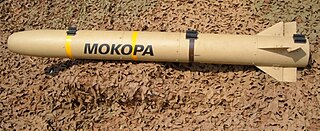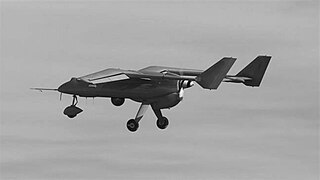Related Research Articles

The AGM-88 HARM is a tactical, air-to-surface anti-radiation missile designed to home in on electronic transmissions coming from surface-to-air radar systems. It was originally developed by Texas Instruments as a replacement for the AGM-45 Shrike and AGM-78 Standard ARM system. Production was later taken over by Raytheon Corporation when it purchased the defense production business of Texas Instruments.

The AGM-65 Maverick is an air-to-ground missile (AGM) designed for close air support. It is the most widely produced precision-guided missile in the Western world, and is effective against a wide range of tactical targets, including armor, air defenses, ships, ground transportation and fuel storage facilities.

A cruise missile is an unmanned self-propelled guided vehicle that sustains flight through aerodynamic lift for most of its flight path and whose primary mission is to place an ordnance or special payload on a target. Cruise missiles are designed to deliver a large warhead over long distances with high precision. Modern cruise missiles are capable of traveling at high subsonic, supersonic, or hypersonic speeds, are self-navigating, and are able to fly on a non-ballistic, extremely low-altitude trajectory.

The General Atomics MQ-1 Predator is an American remotely piloted aircraft (RPA) built by General Atomics that was used primarily by the United States Air Force (USAF) and Central Intelligence Agency (CIA). Conceived in the early 1990s for aerial reconnaissance and forward observation roles, the Predator carries cameras and other sensors. It was modified and upgraded to carry and fire two AGM-114 Hellfire missiles or other munitions. The aircraft entered service in 1995, and saw combat in the war in Afghanistan, Pakistan, the NATO intervention in Bosnia, the NATO bombing of Yugoslavia, the Iraq War, Yemen, the 2011 Libyan civil war, the 2014 intervention in Syria, and Somalia.

The AGM-114 Hellfire is an American missile developed for anti-armor use, later developed for precision drone strikes against other target types, especially high-value targets. It was originally developed under the name "Heliborne laser, fire-and-forget missile", which led to the colloquial name "Hellfire" ultimately becoming the missile's formal name. It has a multi-mission, multi-target precision-strike ability and can be launched from multiple air, sea, and ground platforms, including the MQ-1 Predator and MQ-9 Reaper. The Hellfire missile is the primary 100-pound (45 kg) class air-to-ground precision weapon for the armed forces of the United States and many other countries. It has also been fielded on surface platforms in the surface-to-surface and surface-to-air roles.

An unmanned combat aerial vehicle (UCAV), also known as a combat drone, fighter drone or battlefield UAV, is an unmanned aerial vehicle (UAV) that is used for intelligence, surveillance, target acquisition, and reconnaissance and carries aircraft ordnance such as missiles, anti-tank guided missiles (ATGMs), and/or bombs in hardpoints for drone strikes. These drones are usually under real-time human control, with varying levels of autonomy. UCAVs are used for reconnaissance, attacking targets and returning to base; unlike kamikaze drones which are only made to explode on impact, or surveillance drones which are only for gathering intelligence.

A directed-energy weapon (DEW) is a ranged weapon that damages its target with highly focused energy without a solid projectile, including lasers, microwaves, particle beams, and sound beams. Potential applications of this technology include weapons that target personnel, missiles, vehicles, and optical devices.

Brimstone is a ground or air-launched ground attack missile developed by MBDA UK for the UK's Royal Air Force. It was originally intended for "fire-and-forget" use against mass formations of enemy armour, using a millimetre wave (mmW) active radar homing seeker to ensure accuracy even against moving targets. Experience in Afghanistan led to the addition of laser guidance in the dual-mode Brimstone missile, allowing a "spotter" to pick out specific and the highest priority targets, particularly useful to minimise collateral damage when friendly forces or civilians were in the area. The tandem shaped-charge warhead is much more effective against modern tanks than older similar weapons such as the AGM-65G Maverick missile. Three Brimstones are carried on a launcher that occupies a single weapon station, allowing a single aircraft to carry many missiles.

The ZT-6 Mokopa is a South African air-to-ground anti-tank guided missile. As of 2005, it is in its final stages of development, and is being integrated onto the South African Air Force's Rooivalk attack helicopters. The missile is produced by Denel Dynamics, formerly Kentron. The current version uses semi-active laser (SAL) guidance, requiring the target to be illuminated by a laser designator either on the launch platform or elsewhere; though there are alternative guidance packages available including a millimetre-wave radar (MMW) seeker and a two-colour imaging infrared (IIR) seeker.

The AGR-20 Advanced Precision Kill Weapon System (APKWS) is a design conversion of Hydra 70 unguided rockets with a laser guidance kit to turn them into precision-guided munitions (PGMs). APKWS is approximately one-third the cost and one-third the weight of the current inventory of laser-guided weapons, has a lower yield more suitable for avoiding collateral damage, and takes one quarter of the time for ordnance personnel to load and unload.

The AGM-176 Griffin is a lightweight, precision-guided munition developed by Raytheon. It can be launched from the ground or air as a rocket-powered missile or dropped from the air as a guided bomb. It carries a relatively small warhead, and was designed to be a precision low-collateral damage weapon for irregular warfare. It has been used in combat by the United States military during the War in Afghanistan.

A precision-guided munition (PGM), also called a smart weapon, smart munition, or smart bomb, is a type of weapon system that integrates advanced guidance and control systems, such as GPS, laser guidance, or infrared sensors, with various types of munitions, typically missiles or artillery shells, to allow for high-accuracy strikes against designated targets. PGMs are designed to precisely hit a predetermined target, typically with a margin of error that is far smaller than conventional unguided munitions. Unlike unguided munitions, PGMs use active or passive control mechanisms capable of steering the weapon towards its intended target. PGMs are capable of mid-flight course corrections, allowing them to adjust and hit the intended target even if conditions change. PGMs can be deployed from various platforms, including aircraft, naval ships, ground vehicles, ground-based launchers, and UAVs. PGMs are primarily used in military operations to achieve greater accuracy, particularly in complex or sensitive environments, to reduce the risk to operators, lessen civilian harm, and minimize collateral damage. PGMs are considered an element of modern warfare to reduce unintended damage and civilian casualties. It is widely accepted that PGMs significantly outperform unguided weapons, particularly against fortified or mobile targets.

The Harpoon is an all-weather, over-the-horizon, anti-ship missile manufactured by McDonnell Douglas. The AGM-84E Standoff Land Attack Missile (SLAM) and later AGM-84H/K SLAM-ER are cruise missile variants.

The Burraq is an unmanned combat aerial vehicle (UCAV) jointly developed and built by the National Engineering and Scientific Commission (NESCOM) and the Pakistan Air Force (PAF).

Martlet or the Lightweight Multirole Missile(LMM) is a lightweight air-to-surface, air-to-air, surface-to-air, and surface-to-surface missile developed by Thales Air Defence for the United Kingdom. It is named after a mythical bird from English heraldry that never roosts, the Martlet.
Drone warfare is a form of warfare using robots. Robot types include unmanned combat aerial vehicles (UCAV) or weaponized commercial unmanned aerial vehicles (UAV), unmanned surface vehicles, and ground based drones. The United States, the United Kingdom, Israel, China, South Korea, Iran, Iraq, Italy, France, India, Pakistan, Russia, Turkey, Ukraine, and Poland are known to have manufactured operational UCAVs as of 2019.
A loitering munition, also known as a suicide drone, kamikaze drone, or exploding drone, is a kind of aerial weapon with a built-in warhead that is typically designed to loiter around a target area until a target is located, then attack the target by crashing into it. Loitering munitions enable faster reaction times against hidden targets that emerge for short periods without placing high-value platforms near the target area and also allow more selective targeting as the attack can be changed mid-flight or aborted.

Bayraktar Akıncı is a high-altitude long-endurance (HALE) unmanned combat aerial vehicle (UCAV) being manufactured by the Turkish defence company Baykar. The first three units entered service with the Turkish Armed Forces on 29 August 2021.

The Shahpar-ll is an unmanned combat aerial vehicle (UCAV) built by Global Industrial Defence Solutions of Pakistan. It is currently in production following the completion of a test and qualification phase.
References
- ↑ "Armed drone, laser-guided missile tested". Dawn. 14 March 2015. Retrieved 19 March 2019.
- ↑ "Pakistan successfully tests first indigenous armed drone: ISPR".
- ↑ "Daily chart: Drone attacks and terrorism in Pakistan". The Economist . 23 September 2015. Retrieved 28 September 2015.